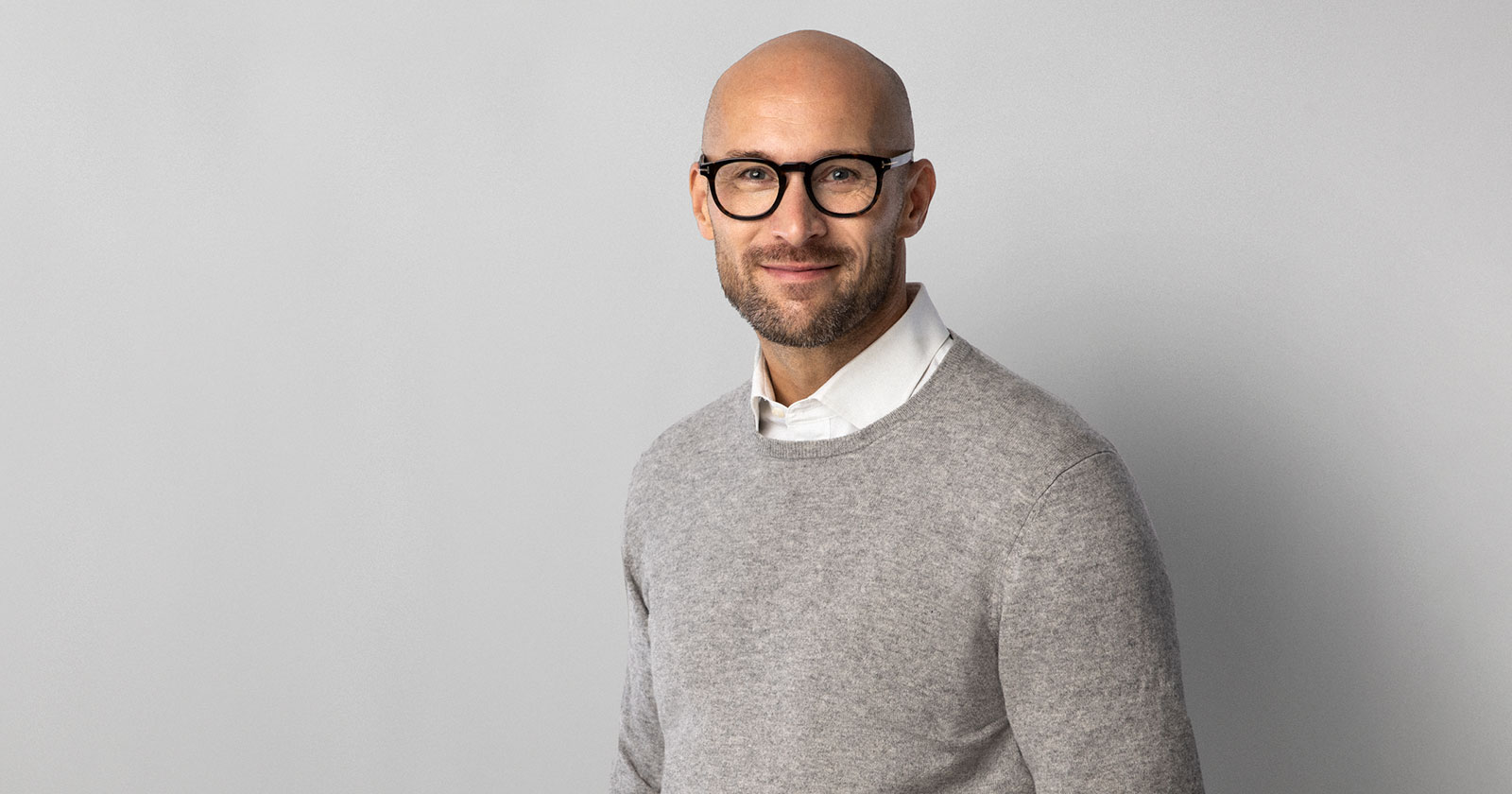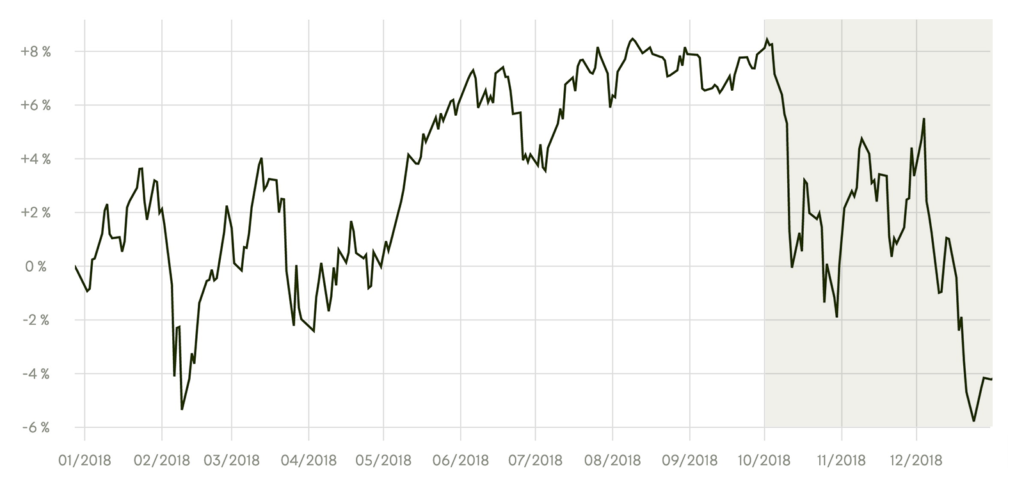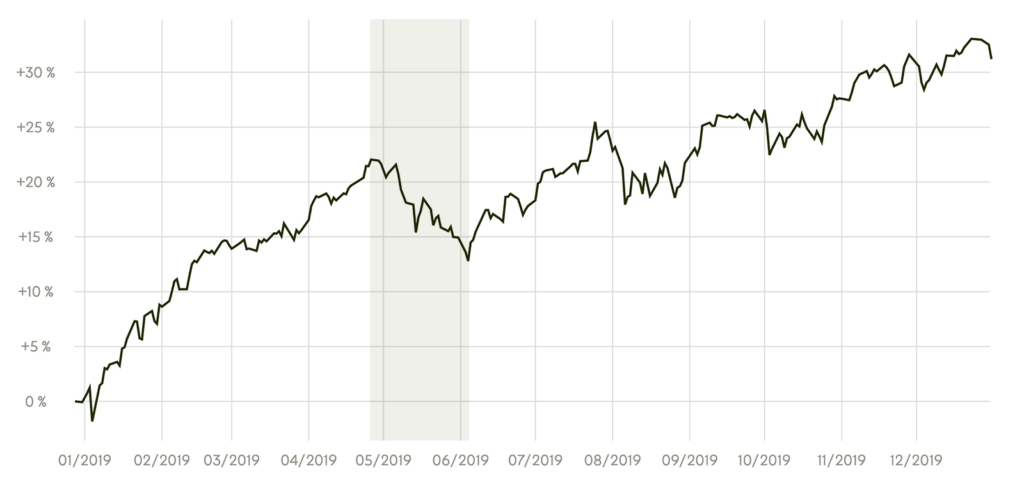For many investors, the stock markets are like a carousel. Sometimes they wait for it to slow down so they can jump on. When it eventually slows down, they are worried it will come to a complete halt. Ultimately, they end up just standing by and watching. This natural psychological phenomenon tends to keep us from taking action. What we need is a different mindset.
In a nutshell, the past five years have been quite volatile. However, our quality investment strategy has yielded excellent results. Sifter Fund Global is ranked as the best fund by Morningstar in the category, based on five-year returns among 1,517 Global Large Cap Blend Equity funds.
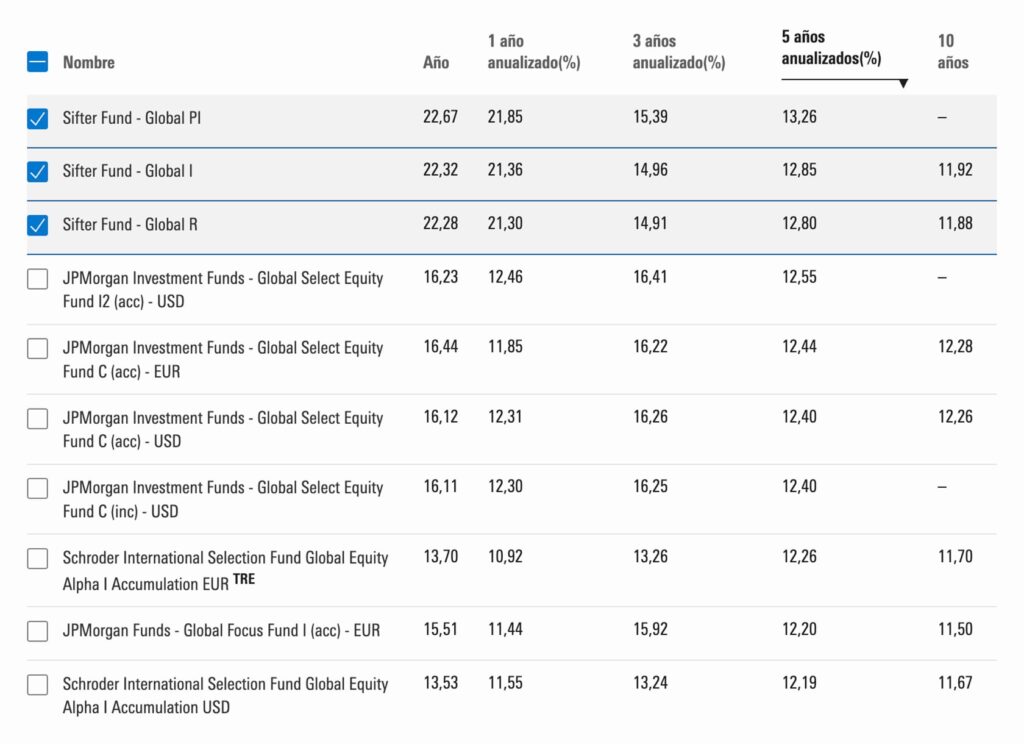
Timing the stock market is impossible
The past five and half years have held some unusual moments for many investors. Personally, I’ve become even more convinced that timing the stock market is impossible.
That is why Sifter’s strategy is to keep owning shares in high-quality companies regardless of market fluctuations.
2018 – “Share prices can’t go any higher”
In 2018, many investors and media outlets strongly believed that the stock market carousel had reached its highest speed and prices could not go any higher. They sought to justify this view by suggesting that the stock markets had been rising for too long, the global economy was slowing down and there were tensions between the United States, North Korea and China.
Many investors expected a market correction that would create the opportunity to invest more. Indeed, there was a long-awaited slight dip in the market near the end of the year. The Sifter Fund also declined by 12% between the beginning of October and the end of December. Many investors decided to wait and see whether the decline would continue once it had begun.
It didn’t.
2019 – Growth continues after all
Year 2019 began surprisingly with strong growth. The value of the Sifter Fund grew by 24% during the spring (January 1–April 30, 2019). Those who had decided to wait on the sidelines were disappointed. They now thought the upward move had been too sharp. Consequently, their only logical move was to wait for the next downward correction.
The spring and summer of 2019 did bring a brief, month-long dip of 7% (May 1–June 4). However, this was not enough of a decline for those who were waiting for a larger correction – after all, prices had already been lower in 2018.
Again, waiting was not rewarded. The stock markets then went on an upward trajectory toward the end of 2019, with 16% growth (June 5–December 31, 2019). Quality Investing generated an annual return of +31.3% to the Sifter Fund in 2019.
“Share prices must come down after rising so sharply,” the papers said.
2020 – The COVID-19 pandemic takes the world by surprise
The year 2020 started with the same trend of moderate growth. The Fed had already started to raise interest rates, which slowed down the rise of prices in the US stock market to some extent. Some of the investors who had waited for a downward correction for a long time decided to finally invest at least part of their available funds. There didn’t seem to be many alternatives and the global economy kept moving forward, albeit at a slower pace.
In late January, news began to come out of China about a threatening virus, but the Western world initially believed that the new virus was only a problem for China to contend with.
On the weekend of February 15–16, Italy awoke to COVID-19. Investors responded to the news of the spread of the outbreak and the uncertainty it caused by panic selling. Sifter’s value fell by 31% (February 17–March 24). By comparison, the S&P 500 declined by 34% and the Eurostock 50 index by 38%.
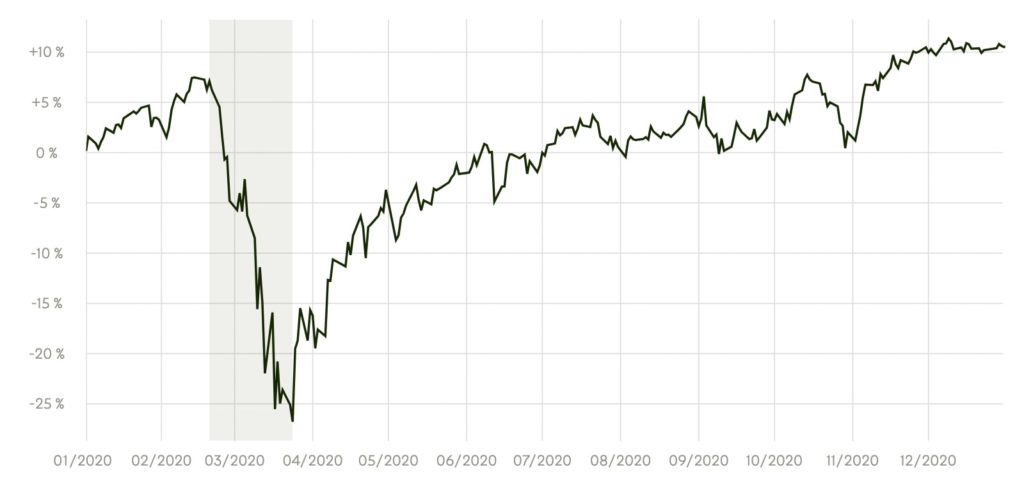
The stock markets had finally returned to the levels seen in September 2017. More than two years of growth evaporated in a month.
Unfortunately, the potentially lucrative dip also came with a significant increase in uncertainty about the future. There was talk of the worst recession ever seen, bankruptcies and, of course, the illness itself.
For investors who want to time the market, this would have been the right moment to take action.
The carousel nearly came to a standstill, but only for a moment. The price rally that followed in the subsequent months took almost everyone by surprise. Sifter’s value increased by 35% (March 27–May 30) practically over a period of two months, returning to the level seen at the beginning of the year.
Still, many people thought the fall and rise had been too sharp. It would be better to wait for the markets to decline again.
However, things turned out differently. Central banks and governments continued their stimulus measures. Not even the US presidential elections or the umpteenth wave of the coronavirus managed to spook the stock markets anymore.
Despite a tumultuous year and strong volatility, 2020 yielded a +10.5% annual return for Sifter Fund investors.
2021 – A Surprise guest arrived at the party: Mr. Inflation
January 2021 started on a very strong note. It was only a matter of time before the COVID-19 vaccine would be ready and the spending spree could begin.
There was pent-up demand everywhere, except for staying at home.
In April, we received the long-awaited company results, which were surprisingly excellent. The markets had anticipated future cash flow celebrations, and alongside them, the Sifter Fund also rose by 13.9% (from January to May 2021).
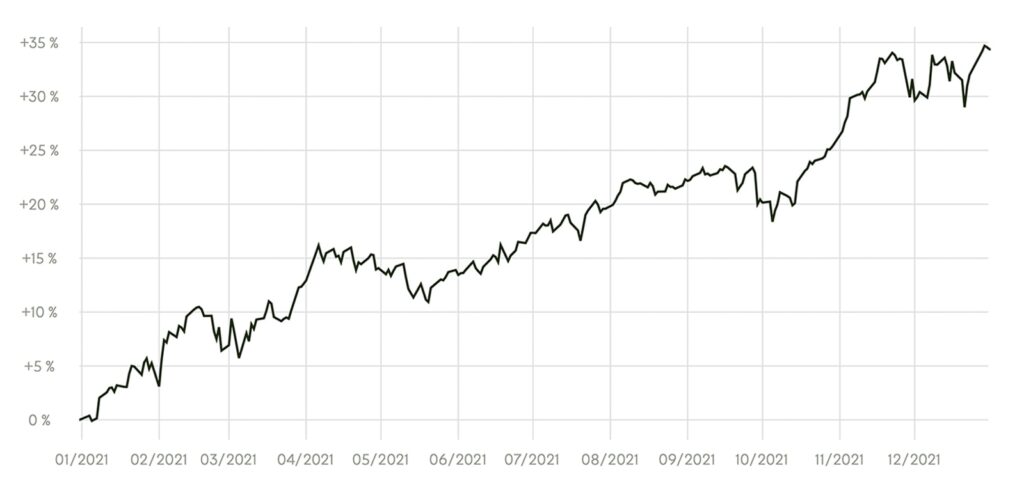
As summer approached, COVID-19 seemed almost familiarly safe, and the economy was steaming ahead. Unfortunately, the party was joined by a long-missing guest named Mr. Inflation.
Markets were once again puzzled by the new uncertainty, and a familiar mantra echoed in investors’ minds – it’s never the right time to invest.
In the spring of 2021, it would have been an excellent time to get into stocks, as the market’s bullishness continued to the end of the year, regardless of inflation concerns.
The year 2021 was recorded in the history of the Sifter Fund as its strongest upward year, with growth exceeding 35%.
2022 – The decline finally came, and War
In January 2022, central banks were poised for severe actions. The US Federal Reserve had resolved to subdue the surging inflation, and there was talk of a Volcker-style approach.
Paul Volcker was a legendary central bank leader (1979-1987) who wrestled the prolonged inflationary spiral but also stifled the entire US economy into a recession with excessive interest rate hikes.
The FED took drastic measures and raised interest rates from zero to five percent in a year (4/2022-6/2023). This alarmed investors, especially growth company stocks plummeted since money had a cost again.
In March 2022, events unfolded that many believed were no longer possible. War in Europe.
This was the final straw for many investors, particularly Finnish companies with extensive business activities suffered greatly.
Russia’s invasion of Ukraine, high inflation, and steep interest rate hikes spooked investors severely, resulting in a 14.5 percent decline for the Sifter Fund in 2022.
A small defensive victory in a challenging market. We remained 100% invested in stocks. Global diversification helped.
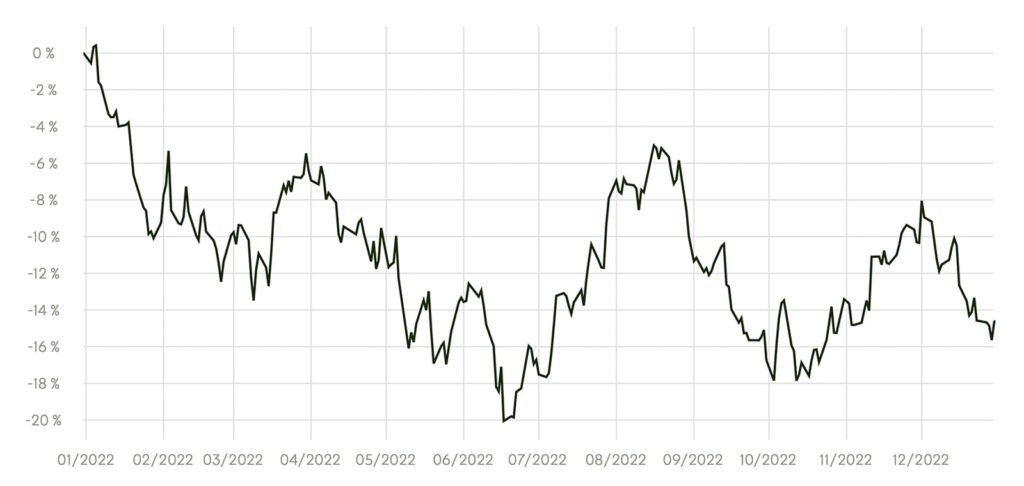
Tech, growth, and semiconductor companies plummeted. We saw a long-term quality investor’s buying opportunity and added quality semiconductor companies to the portfolio at up to a 50% discount on their previous years stock price.
Many seasoned investors over the years were vigilant in the fall and began stock purchases, even though the uncertainties of the macro world were still fresh in memory.
2023 – The wheat separates from the chaff
Stock markets have a unique ability to absorb new information and risks, chew on them for a moment, and then forget them. This happened in early 2023.
The war in Ukraine continued, inflation was still high, interest rate hikes persisted, and even a recession was being discussed.
Concerns began to emerge in the real economy as well. There were profit warnings, but at the same time, some companies continued their growth. The wheat separated from the chaff.
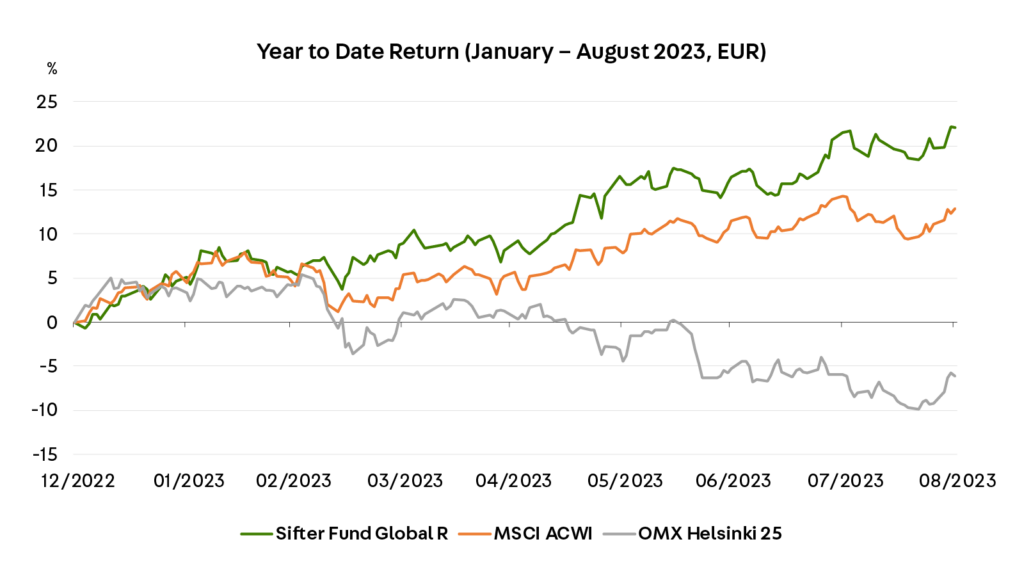
The performance of the Sifter Fund (Sifter Fund Global R/I) from January to August 2023 is +22.1%. Over the same period, the MSCI ACWI Index returned 12.9% and the OMX Helsinki 25 Index -6.1%.
During the era of free money, companies that had accumulated debt began to grapple with financial issues.
The banking sector took a severe beating in March when several American banks collapsed, and in Europe, Credit Suisse crumbled under the weight of its loans.
The troubles in the banking sector did not weigh on Sifter, as we don’t invest in banks. The reason why became evident during the spring.
The stock market looked far ahead and saw the sunshine behind the clouds. If inflation drops, central banks will have to lower interest rates. This began to manifest in the rise of growth company stocks.
The stock choices made by the Sifter Fund over the past year began to bear fruit. Expectations for a decline in interest rates grew, quickly elevating the stocks of technology and semiconductor companies. By August 31, 2023, Sifter’s stock portfolio had already risen 22.1% since the beginning of the year.
The negative performance of the previous year was now more than offset. Is it the right time to invest in stocks now? We don’t know.
Has it paid off to invest in stock market?
Despite all the uncertainty, over the past five and a half years, the value of the Sifter Fund has increased by more than 90% (from January 1, 2018, to August 31, 2023, R/I class).
This period has included several drops of more than 10%, a more than 30% drop due to the coronavirus crash (2020), and a bear market in 2022.
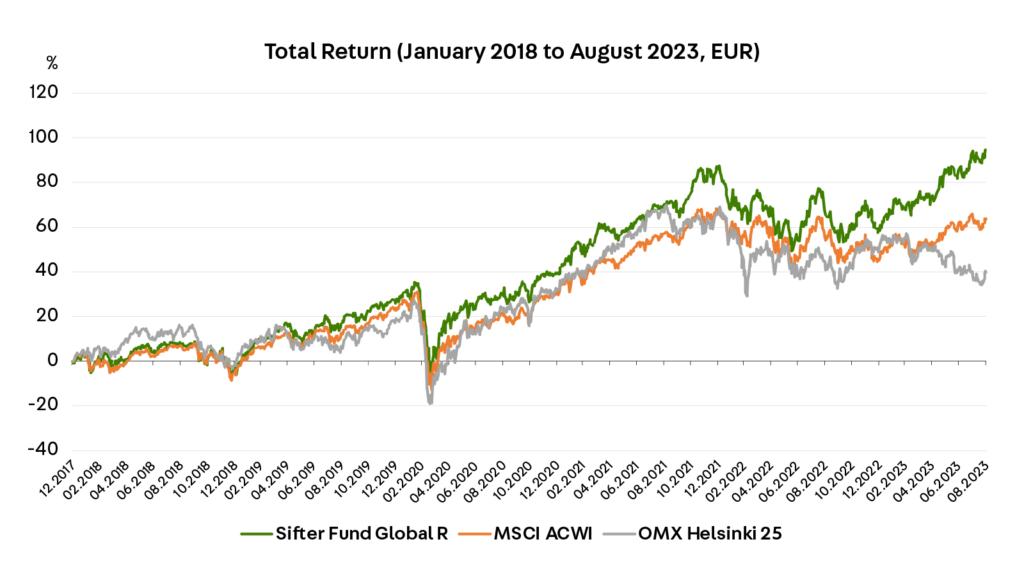
The quality strategy of the Sifter Fund has delivered better returns over this period than the global stock index (MSCI ACWI) or the Helsinki Stock Exchange (OMX Helsinki 25).
The past five and a half years have been an exceptionally eventful period in the stock market. For those waiting for buying opportunities, the only certainty is that uncertainty will continue. Always. It’s the price of equity investing, which must be endured if one seeks returns.
Historically, quality stocks have been profitable
I present an alternative approach that sounds rather simple.
- Buy carefully selected high-quality companies with a strong earnings model.
- Watch the company’s ability to make money and sustain a competitive advantage.
- Replace the company when you find a better one or when the company’s earnings model is permanently diminished.
For many people, such a calm and systematic approach to investment is a strange idea. Indeed, it’s not a question of investing, it’s a question of owning.
The role of the Sifter Fund is to act as that part of an investor’s equity portfolio where you can remain as an owner even when the stock market is ebbing.
How has our fund managed to achieve a return of over 90% during this period of uncertainty? The answer lies in our systematic investment style.
Long-term quality investing best describes Sifter’s investment style. We have also written a guide on the topic: Long-Term Quality Investing.
Santeri Korpinen
CEO, Sifter Capital
